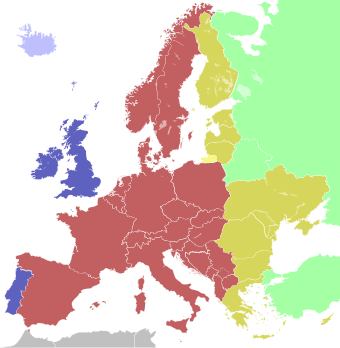Coordinated Universal Time
Coordinated Universal Time (or UTC) is the standard time system of the world. It is the standard by which the world regulates clocks and time. It is, within about 1 second, mean solar time at 0° longitude.

| Blue | Western European Time (UTC±00:00) Western European Summer Time (UTC+01:00) |
| Light Blue | Western European Time (UTC±00:00) |
| Red | Central European Time (UTC+01:00) Central European Summer Time (UTC+02:00) |
| Ochre | Eastern European Time (UTC+02:00) Eastern European Summer Time (UTC+03:00) |
| Yellow | Kaliningrad Time (UTC+02:00) |
| Green | Moscow Time / Turkish Time (UTC+03:00) |
▉▉▉ Dark colours: Summer time observed
The standard before was Greenwich Mean Time (GMT). UTC and GMT are almost the same. In fact, there is no practical difference which would be noticed by ordinary people.[1]
Some websites, for example Wikipedia, use UTC because it does not make any country look more important than the others. It offers one time for all the Internet (the same time can be used by people all over the world).
Time zones are often named by how many hours they are different from UTC time. For example, UTC−5 (United States east coast) is 5 hours behind UTC. If the time is 07:00 UTC, the local time is 02:00 in New York (UTC−5) and 10:00 in Moscow (UTC+3).
07:00 UTC is also written more simply as 0700Z (or 07:00Z).
Note that UTC uses the 24-hour clock. That means there is no 'AM' or 'PM'. For example, 4:00PM would be 16:00 or 1600. UTC also does not use daylight saving time - that way the time stays consistent the entire year.
When this page loaded, it was Sunday, 2024 December 22, 03:00 in UTC.
 |
References
change- ↑ Guinot, Bernard 2011. Solar time, legal time, time in use. Metrologica 48 (4): S181–185. [1][permanent dead link]